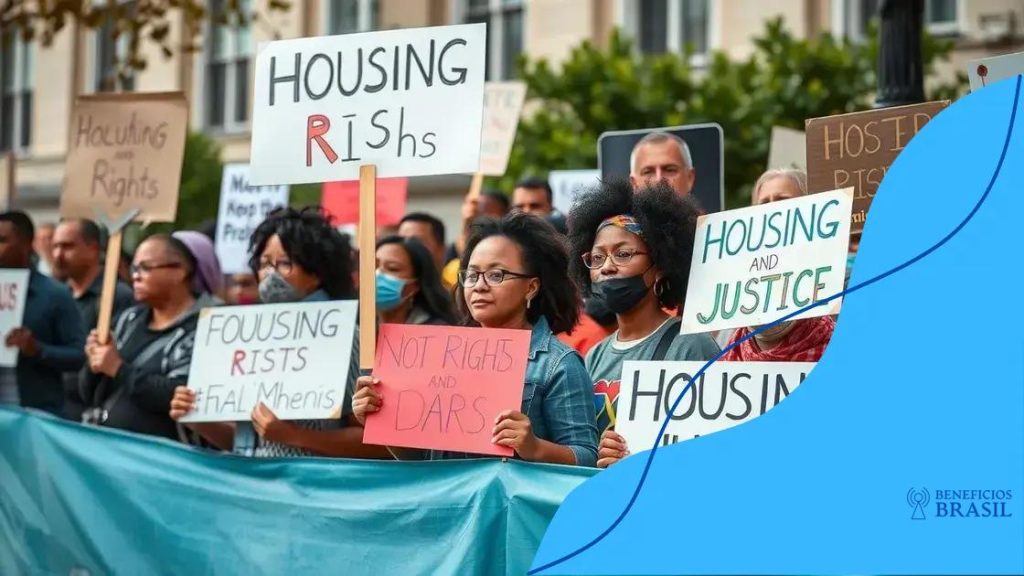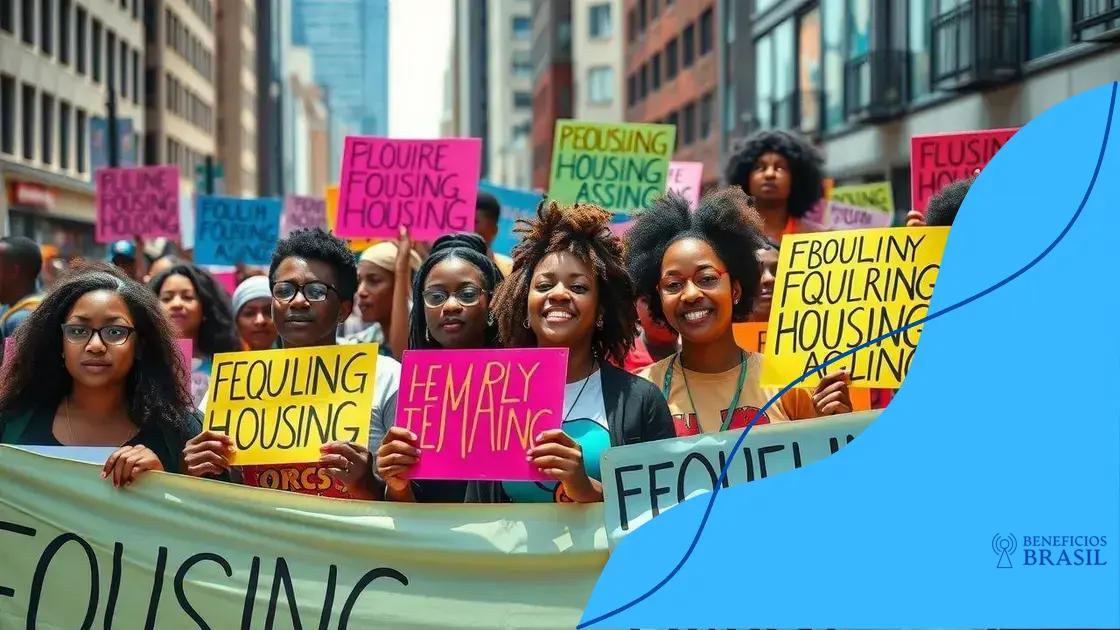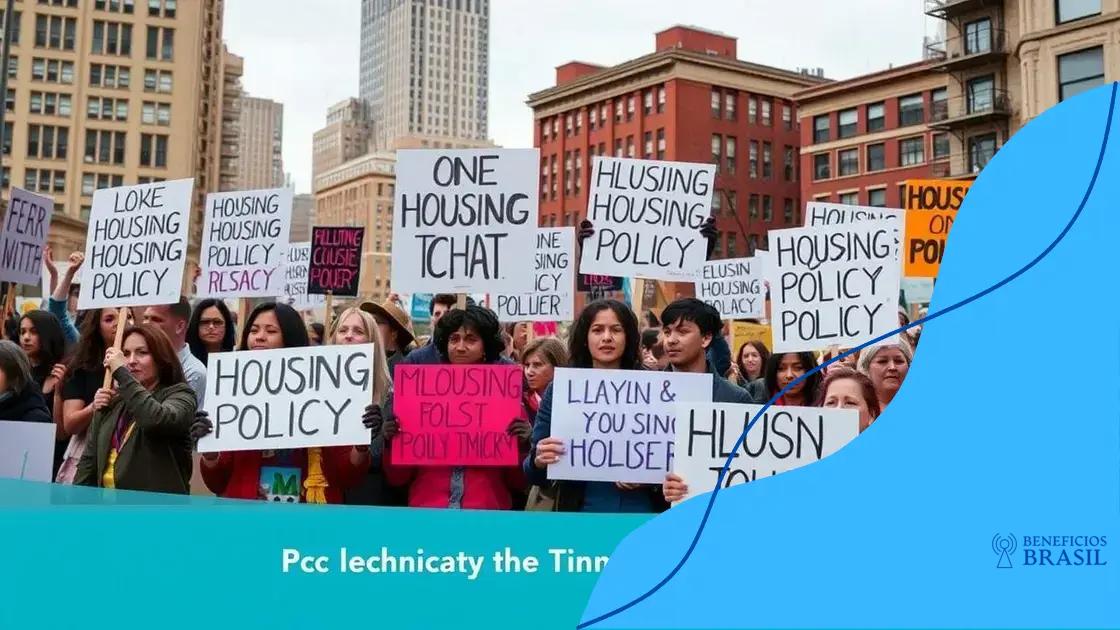Anti-displacement housing justice protests: what you should know

Anti-displacement housing justice protests are critical for advocating affordable housing and protecting communities from displacement, mobilizing residents to address housing issues effectively.
Anti-displacement housing justice protests have become a powerful force in advocating for the rights of displaced communities. Every protest echoes a demand for housing equity, making us wonder what steps we can take to support these vital causes.
Understanding anti-displacement housing justice
Understanding anti-displacement housing justice is essential for recognizing the impact of gentrification and housing policies on vulnerable communities. The movement advocates for the right to remain in one’s home, emphasizing everyone’s need for secure and affordable housing.
The importance of housing justice
Housing justice is critical for social equity. When communities face displacement, they lose not only their homes but also their cultural identity and support networks. This struggle highlights the need for systematic change to protect resident rights.
Key principles of anti-displacement
- Affordability: Ensuring housing prices align with local incomes
- Community control: Empowering local residents in housing decisions
- Diversity: Promoting a mix of housing types to support all income levels
- Equity: Addressing historical injustices to create fair housing opportunities
Understanding these principles helps in creating awareness and mobilizing community action. Awareness of the ongoing struggles is a powerful tool for driving change.
Effective advocacy strategies
Successful movements employ various strategies to combat displacement. Grassroots organizing often brings community members together, fostering solidarity and amplifying voices. Advocacy can also involve policy change through lobbying local governments to enact supportive laws.
Events like community meetings, rallies, and public forums can engage more individuals in the conversation. These actions ensure that the fight against displacement gains momentum and visibility.
Conclusion
Recognizing the importance of anti-displacement housing justice is the first step toward influence and change. By understanding the core principles and advocating for effective strategies, communities can work together to create lasting impacts that shield vulnerable populations from displacement.
The role of community activism in protests

The role of community activism in protests is vital for raising awareness and generating change. Activism provides a collective voice that emphasizes the urgent need for affordable housing and the fight against displacement.
Building a strong community network
Community activism fosters connections among residents, making it easier for them to unite around a common cause. By organizing meetings and events, activists can educate their neighbors about housing issues.
- Creating alliances with local organizations
- Engaging with local leaders for support
- Facilitating workshops on housing rights
- Promoting inclusive participation across demographics
This network empowers residents to advocate for their rights and strengthens the overall movement. A well-connected community can mobilize quickly in response to threats of displacement.
Effective protest tactics
Community activism utilizes various strategies during protests to amplify their message. Demonstrations, art installations, and social media campaigns are just a few ways to raise awareness.
Grassroots initiatives often attract media attention, which can further spread their message.
By using creative methods, activists can draw in supporters from diverse backgrounds, making their cause resonate widely. This approach not only builds solidarity but also attracts allies who may not have been aware of the issues at hand.
Challenges faced by activists
Despite their efforts, community activists often face challenges such as pushback from authorities or misrepresentation in media. These hurdles can hinder their progress. However, resilience is essential in the fight for justice.
Many activists learn to navigate these obstacles, adapting their strategies to maintain momentum and support.
The presence of community members at protests creates a protective environment, encouraging more individuals to join, which ultimately strengthens their cause. Through organized efforts and shared experiences, community activists can make impactful strides toward achieving housing justice.
Key players in housing justice movements
The key players in housing justice movements are essential for driving change and advocating for the needs of communities facing displacement. These individuals and organizations work together to promote affordable housing and protect residents’ rights.
Community organizations
Local community organizations often lead the charge in housing justice movements. They provide resources, education, and support to residents and help mobilize people to take action.
These groups focus on grassroots advocacy, which empowers communities to speak up for their needs.
- Advocacy groups
- Nonprofits focused on housing issues
- Neighborhood associations
- Faith-based organizations
Through their efforts, they aim to influence housing policies and challenge unjust practices that threaten community stability.
Grassroots activists
Grassroots activists play a crucial role in raising awareness and uniting community members for protests and campaigns. Many activists come from the communities they represent, giving them firsthand knowledge of the challenges residents face.
These activists often use social media and local events to spread their message and rally support. Their passion and commitment fuel movements, making their voices vital in the fight for housing justice.
Policy makers and allies
Policy makers are also key players in housing justice movements. They have the power to create and enforce laws that protect residents and ensure affordable housing options. Working with community organizers, policy makers can help translate grassroots demands into actionable policies.
Allies from various sectors can help strengthen movements. Academics, urban planners, and legal advocates contribute valuable insights and resources to support advocacy efforts. Together, these diverse players form a robust network focused on achieving housing justice.
Impact of protests on housing policies

The impact of protests on housing policies can be significant, as they highlight community issues and push for changes that support affordable housing. When residents voice their concerns in public forums, lawmakers often take notice.
Changing public perception
Protests can change public perception about housing issues. When large groups gather, they draw media attention, which exposes the struggles of displaced residents to a wider audience.
- Increased awareness of housing rights
- Shift in community attitudes towards displacement
- Encouragement for others to advocate
- Motivation for legal reforms
This increased awareness can lead to public support for more equitable housing policies and initiatives.
Influencing policy decisions
Direct action through protests often prompts local authorities to reconsider their policies. Elected officials may feel pressured to respond to constituents’ demands for change. When protests become large and persistent, they signal that housing issues cannot be ignored.
Advocacy efforts can result in notable policy changes, such as rent control measures or increased funding for affordable housing projects. These changes reflect the voices of those affected by housing crises.
Building coalitions for change
Protests can also foster coalitions between different organizations and community members. By uniting various groups, the housing justice movement can amplify its message and push for comprehensive reforms.
These collaborations often lead to sustained efforts that tackle housing inequality, creating a stronger foundation for long-term change. Activists can effectively address related issues, such as homelessness and displacement, by working together.
Challenges faced by housing justice advocates
Housing justice advocates face numerous challenges as they fight for the rights of those affected by displacement. Understanding these challenges is essential to appreciate their efforts and resilience in driving change.
Resistance from authorities
One significant challenge is pushback from local authorities and developers. When advocates push for reforms, they often encounter resistance from those who benefit from the current systems.
This can make it difficult to propose new policies that protect vulnerable communities.
- Intimidation tactics employed by developers
- Lack of political support for housing initiatives
- Regulatory hurdles that stall progress
- Limited funding for advocacy efforts
Such resistance can create a sense of frustration among advocates, as they strive to bring about change while facing powerful opposition.
Public awareness and engagement
Another challenge is raising public awareness about the importance of housing justice. Many people may not fully understand the issues at stake, which can make it hard to garner widespread support.
Advocates often need to ensure that the community is informed and engaged. This involves organizing events, creating informative materials, and using social media to spread their message.
Resource limitations
Limited resources can also hinder the effectiveness of housing justice advocates. Many organizations operate on tight budgets and rely heavily on volunteers. This can restrict their ability to carry out extensive outreach or legal work.
As a result, they may struggle to meet the demands of their constituents while also addressing systemic injustices in housing.
Complexity of housing laws
Navigating the complex landscape of housing laws and policies adds another layer of difficulty. Understanding local regulations can be daunting, especially for those unfamiliar with legal jargon. Advocates must stay informed about changes in laws that affect housing rights.
By overcoming these challenges, housing justice advocates continue to strive for change, impacting the lives of many individuals and families.
FAQ – Frequently Asked Questions about Housing Justice Advocacy
What is housing justice?
Housing justice is the movement to ensure that everyone has access to safe, affordable, and stable housing, free from discrimination and displacement.
What challenges do housing advocates face?
Housing advocates often face resistance from authorities, limited resources, and difficulty in raising public awareness about housing issues.
How do protests impact housing policy?
Protests can draw public attention to housing issues, influence policymakers, and encourage legislative changes that support affordable housing.
What role does community activism play in housing justice?
Community activism unites residents to advocate for their rights, raise awareness, and create pressure for changes in housing policies.
